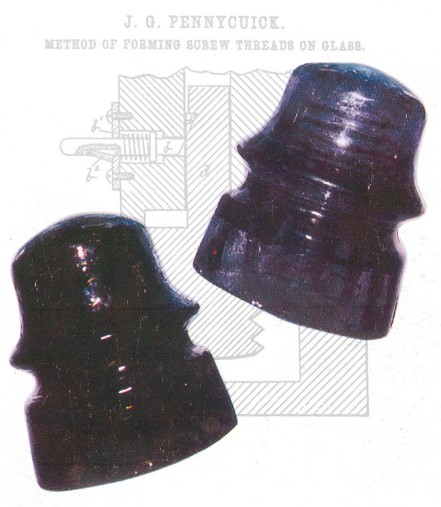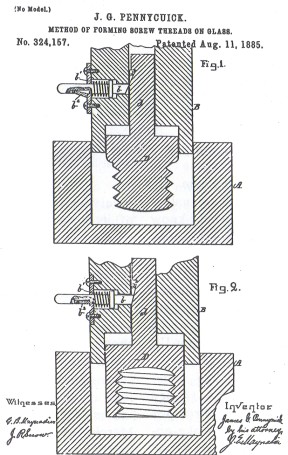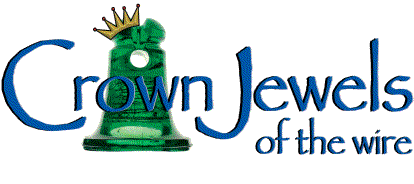Pretty Pennycuicks
by Carol McDougald
Reprinted from "Crown Jewels of the Wire", February 1996, page 3
Say this fast six times...
Pretty Pennycuicks Perched on a Pin
The greatest gift a collector can give to a hobby is to cultivate the fine
art of sharing. Sharing, a lesson most of us learned at a mother's knee, can be
expressed in countless ways within a collectible field.
The insulator hobby has
many who practice sharing on a regular basis. They write regular columns for
insulator publications, share their stories of collecting finds and develop well-researched articles. Many collectors have cultivated snail mail pen pals,
spent cherished minutes of conversations during long distance phone calls and,
most recently, hold "chat" sessions and broadcast e-mail messages to
over one hundred fellow collectors with a single keystroke.
Buying, selling,
trading, opening your home to fellow collectors who turn up in your town
unexpectedly with a few hours to spare and want to pay of visit all reinforce
the fine art of sharing.
Of course, those who take the time to display at an
insulator show will always have my greatest admiration. Imagine, packing up and
removing some of your favorite pieces from the safety of your home, and bringing
them by plane or car to a show to share with fellow collectors.
In recent years,
there have been noncompetitive displays put together by collectors who share a
similar specialty or interest. They combine their pieces to show the best of the
best. Many such displays were amassed at the National show last summer in
Marlborough, Massachusetts. Collectors worldwide were among the participants.
One of the combined displays featured insulators that were manufactured with
threading attributed to the 1885 patent of James Pennycuick. Two insulators in
that display were present because their owners know the fine art of sharing. A
trip to the Enumclaw show in Washington state many years ago introduced Mr. Mac
and me to one of the great collectors of the northwest. Bill Reid, Greenacres, Washington,
brought one of
the most incredible insulators to the show for photographing -- a bubbly
lavender CD 170.1 Pennycuick.
"I received an insulator sales list from Frank Feher, a West Sacramento,
California dealer, sometime in 1983 or 1984. He is a friend of mine and a nice
guy. It was a short list of only a few juicy items. One of them was this CD 170.1
in a bubbly lavender color. At that time I had been collecting almost twenty
years and I remember thinking to myself that I'd never heard of or seen a CD
170.1 in any shade of purple. That evening I called Frank from my home in
Greenacres and he said that he still had the piece and that it was just gorgeous.
I told him to send it along with same others that I ordered. I do clearly
remember that the price tag an the CD 170.1 was $125.00! I received it a few
days later and thought that it was really a neat piece.
Later that week I called
Frank again to get the history an the piece. Frank told me that a power lineman
had taken this piece off a secondary power circuit or possibly a fire alarm
circuit in the East Berkeley-East Bay area (Oakland-Berkeley area) of California.
Frank bought it from the lineman and shortly after that sold it to me.
I see
Frank every May at the Enumclaw show in northwestern Washington and he always
tells me that he would like to have that insulator back. I always tell him 'Not
for $125, Frank!' We both laugh!
Kevin Lawless, from Schenectady, New York called me in early 1995 and wanted
to know if I would send my bubbly lavender CD 170.1 to him so that he could put it in the Pennycuick display at the
Marlborough national. I told him I would send it and the rest is history. I would
like to thank Kevin for putting the insulator in the display and for taking great care
of it during the time that it
was gone from my collection. Also, thanks to Carol and John McDougald for photographing
the piece and putting it with its amber cousin from Florida on the cover of Crown Jewels of the
Wire."
Several years later, when Mr. Mac and I were embarking upon photographic
research for a reference book, at that time one of the major collections in the
northeast belonged to Tom Moulton of Ballston Spa, New York. Tom and his wife
Alice now live in Plant City, Florida. Present in Tom's collection was an
olive amber CD 170.l!
"The deep olive amber CD 170.1 seen at the recent National Show in
Massachusetts was removed from the roof of the International Paper Company in downtown
Ticonderoga, New York. I have called International Paper and requested information
on when it was constructed, but the contacts I had there when I was
calling on them for Holophane, are gone and I have gotten nowhere. If something does
came in I will fax it to you -- don't hold your breath.
The old mill was torn down and the manufacturing facility was moved to a more
remote location in
1970-1971. I purchased the piece, I would guess, in the summer of 1971 at a flea
market in the old ice skating rink in Saratoga Springs, New York. I don't exactly
know why I remember all about the purchase. Lord knows, I hardly
remember what I did on the golf course today (maybe I want to forget!) I clearly remember,
however, being there with Alice and watching Sterling Finch
pick up the piece (he was always there first!) and then put it down because of
the inner skirt chip. I picked it up and it has been with us since. When I divested
most of the heart of the collection, it was one of the few that I kept. I do not remember what it
cost, but it was not much.
I believe it first appeared
in the 1975 Milholland price schedule ( it was listed, however, as a CD 170) and
was carried in his books after that. I do remember Marion really studying it at
our home in Charlton which is now three homes back. John photographed it when he
spent the two days photographing the collection at our home in Saratoga Springs
in 1988, I believe. If you can find those photos, it is there -- along with a bunch
of other stuff which I wish we owned now.
This hobby is full of memories for me.
One thing that I like is the fact that I can tell where most of the items in the
collection came from now --- and each has a story. Perhaps that is one of the best
parts about having the stuff all over the house."
Now, would you send your treasured insulator from Florida or Washington state
to Massachusetts to take part in a display and not even be able to attend to
keep a watchful eye? THAT IS SHARING! To Tom and Bill, owners of this month's
cover jewels, we say thank you.

February 1996 Cover Photo
Finally, as part of the continuing research by Joe Maurath, Jr. of Abington,
Massachusetts, the most current information available regarding Pennycuick. THANK YOU, Joe, for what you
continually share with others.
"On August 11, 1885, James Pennycuick of Boston, Massachusetts was
granted a patent for a "Method Of Forming Screw Threads On Glass." No
mention about insulators was made within the patent text.
During 1888 the Boston
and Sandwich Glass Company closed their plant, which stood in Sandwich,
Massachusetts on Cape Cod. Mr. Pennycuick purchased this property during
December 1889, ' having recently formed the Electrical Glass Corporation. He was
the company's director and was eager to get the glassworks up and running.
Newspaper accounts of the day indicate that Mr. Pennycuick was very interested
in manufacturing insulators, and almost immediately made prospective customers
aware of his product by distributing insulator samples. Since he did not begin
glassmaking until several months later, he had his samples made by the Sandwich
Cooperative Glass Company. Delays in production and labor problems at Mr.
Pennycuick's plant created a substantial backlog of order for his insulators.
His prospective customers liked the samples and order continued to arrive.
Obstacles he encountered at his glassworks caused him to cease operations during
November 1890, only six months after glass making began. The property was
foreclosed upon a short time later and sold at a public auction.
Nothing is
known about the styles or lettering that concern the insulators produced at the
Sandwich Cooperative Glass Company or at the Electrical Glass Corporation. At a
minimum it seems obvious Mr. Pennycuick identified some with his 1885 patent
date. It is noteworthy that these also bear the letter "P" within a
diamond monogram boldly appearing on their skirts: The letter P on these could
represent Pennycuick; however, no proof currently exists. All appear to have
been threaded by his patent process. These rare specimens have high quality,
fine, concise threading that was unusual for insulators of that time.
The letter P on these could
represent Pennycuick; however, no proof currently exists. All appear to have
been threaded by his patent process. These rare specimens have high quality,
fine, concise threading that was unusual for insulators of that time.
The majority of insulators located with this noticeable, characteristic threading are
unmarked and are known in many styles. Most of these are aqua. Exceptions are
those in light to dark blue and green shades. Some of these are quite intense
and vivid; a few have swirls and bubbles, etc. [Two unique examples of
Pennycuick. threaded insulators are the CD 170.1 s pictured on the cover.] Like
their unmarked counterparts, Diamond-P embossed insulators appear to have been
very well made. These have only been found in CD 134, and many collectors believe they are the most colorful of
all Pennycuick-threaded specimens. The majority of Diamond-P's are aqua. Others
have been located in made shades of blue and green. Interesting examples include
those in sapphire, cornflower and teal blue. Slag, bubbles, swirls and other inconsistencies
add spectacular beauty to some of these oddly colored
insulators. Most Diamond-P insulators have been located in Eastern
Massachusetts. All are rare, even the aqua ones.
Other CD 134 specimens with
lettering and Pennycuick pinhole threads are those with C.E.L.CO. and PETTINGELL
ANDREWS embossing. They are also identical to the outer shape and size of
Diamond-P insulators. These corresponding features suggest the possibility that
the C.E.L. Co. and Pettingell Andrews ones were manufactured by someone who had
rights to access to Pennycuick's threading technique." **

** Pennycuick historic information authored by Joe Maurath, Jr. and printed
in the 1996 National Show Directory Permission granted for reprinting
| 